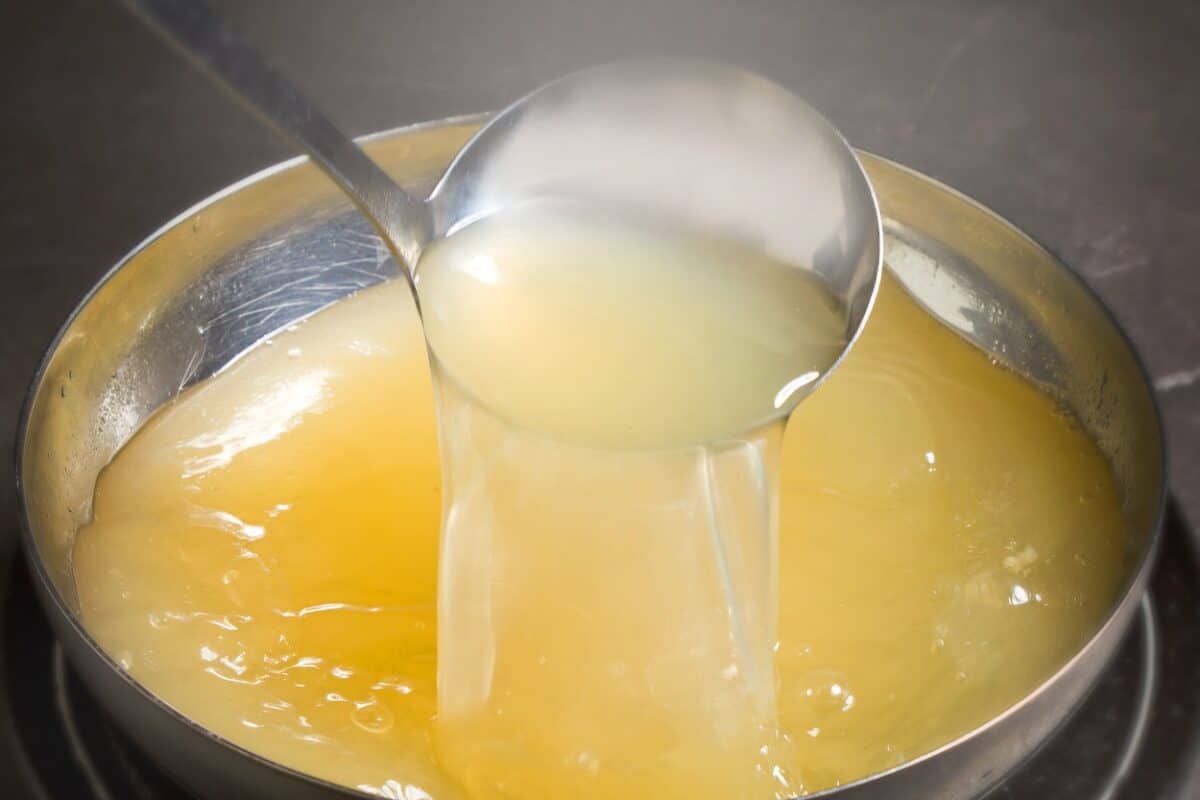Last Updated on 22nd April 2022 by
If you see chicken stock and chicken broth on the shelf at the grocery side by side, you may wonder what’s the difference. Is there any difference or can you use them interchangeably? When a recipe calls for one or the other, does it matter which one you use?
It does matter, and I want to share with you the difference between chicken stock and broth. There are times where one is a better choice than the next, and when that is comes down to what you are making and how you want it to taste. Both of these liquids offer some great chicken flavor, but they come from different parts of the chicken, usually, so that gives you a different texture and taste that you need to know about.
If you make your chicken and dumplings with chicken broth one week and then chicken stock the next week, for example, it will taste different.
What’s the Difference between Chicken Stock and Chicken Broth?
The main difference between these two is that they are made from different parts of the chicken. Your stock comes from the bones, typically, so the taste will be quite different from the broth, which usually comes from the meat. The broth tends to be oilier, since it has a lot of fat in it. The fat and meat get cooked together to make chicken broth, so it’s not as healthy as the stock would be. The stock is more of a lean, lightly flavoured liquid, whereas the broth is more savoury and sweeter.
The difference between chicken stock and chicken broth when it comes to flavour is very noticeable. Chicken stock tends to be very flavourful since it is derived from long-simmering bones. The broth isn’t as flavourful, but it can still be tasty. Even so, it’s often best to add some flavour to your broth to help bring out its natural tones and make it taste good with whatever you are using it for.
One difference between chicken broth and stock is that the broth tends to have a lot more sodium or salt content. It can be packed with sodium, so you may want to opt for the low sodium version. There are usually a lot of different kinds of chicken broth to pick from, and most brands will stock a low sodium version for customers since this is a food that is notorious for its high sodium content. If you are trying to watch your weight and eat healthier but still want to cook with chicken broth, then that low sodium version is the way to go.
Chicken stock has a thicker texture to it. This is due to the gelatin that is cooked out of the bones as the bones are simmered to make stock. That gelatin makes chicken stock an excellent thickener for soups and sauces.
How to Serve Chicken Broth and Chicken Stock
What is the difference between chicken stock and chicken broth in the way they are served? The most obvious difference is that chicken stock is almost never served on its own. It is usually an ingredient in a larger recipe. Chicken broth, on the other hand, can be served on its own and is used as a soup.
You can make chicken broth soup just by adding a bit of garnish to it or packing it with noodles and bits of chicken, but it can also be a warm, comforting food to be eaten on its own, kind of like a tea. Chicken broth is often used to treat colds and sinus infection, as when it is served very hot, it can clear up the sinuses and air pathways.
Chicken stock, on the other hand, can be used in casseroles, rice dishes and as part of a soup that would have a lot of other ingredients. While the stock is flavourful, it isn’t served on its own, though it can be a base for a dish. This difference between chicken broth and chicken stock in how they are served is important if you don’t want to accidentally use the wrong one.
Preparing Chicken Stock and Chicken Broth
What is the difference between chicken broth and chicken stock when it comes to preparation? They can be prepared similarly- by heating the necessary components, but chicken stock takes a lot longer to cook.
I told you that chicken stock is made from bones, but what about vegetable stock? You may have used that before or seen it required in a recipe. Vegetables don’t have bones, though, so what gives? Well, vegetable stock isn’t technically stock, since stock requires bones. It’s prepared the same way as chicken stock but using vegetables instead of animal bones. The preparation method is part of where the name comes from, but technically all vegetable stock is really veggie broth.
To prepare chicken stock, you need to simmer the bones for hours in liquid. This can take most of the day if you are using a slow, simmering method. The stock creates a rich gelatin substance as it cooks, which makes it thicker than broth. Broth tends to be very thin, and if you are asking is there a difference between chicken broth and chicken stock, the thinness or thickness is a key difference.
Chicken broth is made much quicker, and it can be prepared in just a fraction of the time compared to chicken stock. You can boil chicken parts to create a broth, which comes out oily and kind of yellow. That’s the fat making it so oily and yellow, and that is what gives the broth its sweet, pleasing flavour. You can make chicken broth in just 30 minutes. It’s much faster to prepare than stock, so if you are making it on your own, that may be the preferable liquid to make.
With either kind of food, you are adding water to help with the cooking process. The water heats and draws out the flavour from the chicken parts. The longer the chicken cooks, the more flavour will be extracted, which is why stock is so rich in flavour. Of course, bones take longer to cook and it takes longer to get their flavour extracted than it does for chicken meat and gristle.
What’s the difference between chicken broth and chicken stock? Now you know how they differ in prep time, in flavour, in texture, and in the parts used to make them. They can be used for some similar dishes, but they are quite different in a number of ways. Knowing the difference will make it easier to pick the right one based on what you are going to make or what kind of flavour or texture you are going for.
It’s important to use the right one, because you don’t want to accidentally thicken something that is already thick, and you don’t want to add an oily liquid to something that is already oily. Knowing the difference between these two is important for good cooking and ensuring that your food tastes like it should.
I'm Pauline, a mother of four grown children, my passion for cooking stemmed from the joy i get cooking for my family. I love to try new dishes, especially when dining out but creating and sharing my own recipes is my favourite thing to do!



frisk
Friday 21st of February 2025
gbtgvxtX08X